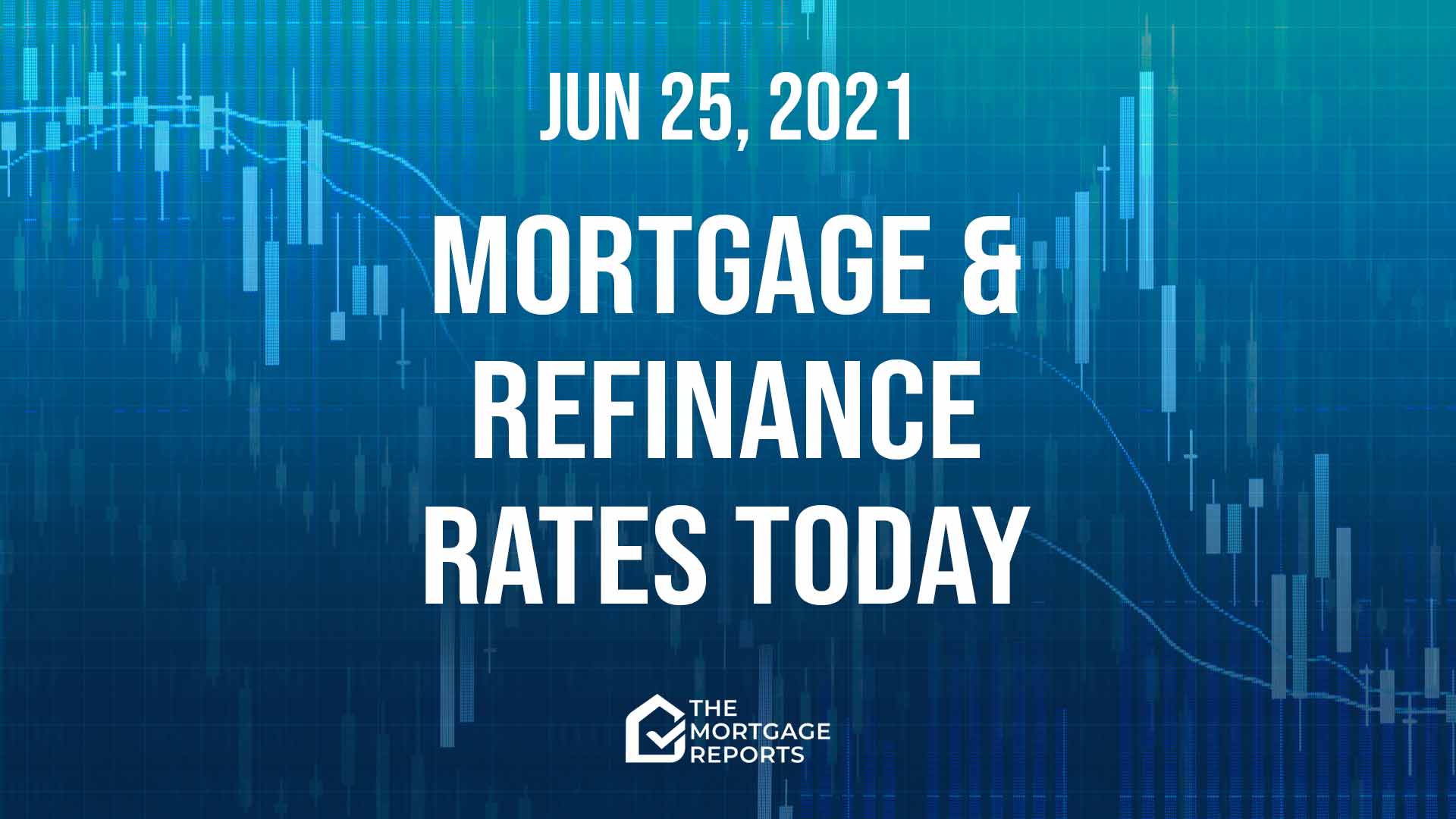
Today’s mortgage and refinance rates
Average mortgage rates inched lower yesterday. Contrary to media reports based on Freddie Mac’s weekly survey, those rates are actually a bit lower than they were this time last week. But they’re way higher than they were two weeks ago.
First thing this morning, it’s again looking as if mortgage rates today might hold steady or almost steady. But there’s plenty going on that could change that later. That includes a new deal on the stimulus program yesterday, and a hot inflation report this morning.
Find and lock a low rate (Jun 25th, 2021)Current mortgage and refinance rates
| Program | Mortgage Rate | APR* | Change |
|---|---|---|---|
| Conventional 30 year fixed | |||
| Conventional 30 year fixed | 2.936% | 2.936% | Unchanged |
| Conventional 15 year fixed | |||
| Conventional 15 year fixed | 2.25% | 2.25% | Unchanged |
| Conventional 20 year fixed | |||
| Conventional 20 year fixed | 2.75% | 2.75% | Unchanged |
| Conventional 10 year fixed | |||
| Conventional 10 year fixed | 1.944% | 1.98% | -0.01% |
| 30 year fixed FHA | |||
| 30 year fixed FHA | 2.779% | 3.437% | Unchanged |
| 15 year fixed FHA | |||
| 15 year fixed FHA | 2.656% | 3.258% | +0.03% |
| 5 year ARM FHA | |||
| 5 year ARM FHA | 2.5% | 3.22% | Unchanged |
| 30 year fixed VA | |||
| 30 year fixed VA | 2.375% | 2.547% | Unchanged |
| 15 year fixed VA | |||
| 15 year fixed VA | 2.25% | 2.571% | Unchanged |
| 5 year ARM VA | |||
| 5 year ARM VA | 2.5% | 2.399% | Unchanged |
| Rates are provided by our partner network, and may not reflect the market. Your rate might be different. Click here for a personalized rate quote. See our rate assumptions here. | |||
COVID-19 mortgage updates: Mortgage lenders are changing rates and rules due to COVID-19. To see the latest on how coronavirus could impact your home loan, click here.
Should you lock a mortgage rate today?
After last week’s appreciable rises, this week seems to have settled back down into its recent pattern of just gentle rises and falls. And, although you can take nothing for granted, that may last a while.
Of course, there will be good weeks (like this one, so far) when falls outweigh rises. But many experts expect these rates to slowly drift upward for now. However, a much sharper rise is on the cards for later in the year.
So my personal rate lock recommendations must remain:
- LOCK if closing in 7 days
- LOCK if closing in 15 days
- LOCK if closing in 30 days
- LOCK if closing in 45 days
- LOCK if closing in 60 days
However, I don’t claim perfect foresight. And your personal analysis could turn out to be as good as mine — or better. So you might choose to be guided by your instincts and your personal tolerance for risk.
Market data affecting today’s mortgage rates
Here’s a snapshot of the state of play this morning at about 9:50 a.m. (ET). The data, compared with roughly the same time yesterday, were:
- The yield on 10-year Treasurys inched up to 1.50% from 1.48%. (Bad for mortgage rates.) More than any other market, mortgage rates normally tend to follow these particular Treasury bond yields, though less so recently
- Major stock indexes were higher soon after opening. (Bad for mortgage rates.) When investors are buying shares they’re often selling bonds, which pushes prices of those down and increases yields and mortgage rates. The opposite may happen when indexes are lower
- Oil prices rose to $73.52 from $72.66 a barrel. (Bad for mortgage rates*.) Energy prices play a large role in creating inflation and also point to future economic activity.
- Gold prices edged up to $1,788 from $1,783 an ounce. (Neutral for mortgage rates*.) In general, it’s better for rates when gold rises, and worse when gold falls. Gold tends to rise when investors worry about the economy. And worried investors tend to push rates lower
- CNN Business Fear & Greed index — increased to 44 from 41 out of 100. (Bad for mortgage rates.) “Greedy” investors push bond prices down (and interest rates up) as they leave the bond market and move into stocks, while “fearful” investors do the opposite. So lower readings are better than higher ones
Caveats about markets and rates
Before the pandemic and the Federal Reserve’s interventions in the mortgage market, you could look at the above figures and make a pretty good guess about what would happen to mortgage rates that day. But that’s no longer the case. We still make daily calls. And are usually right. But our record for accuracy won’t achieve its former high levels until things settle down.
So use markets only as a rough guide. Because they have to be exceptionally strong or weak to rely on them. But, with that caveat, so far mortgage rates today look likely to barely move. But be aware that “intraday swings” (when rates change direction during the day) are a common feature right now.
Find and lock a low rate (Jun 25th, 2021)
Important notes on today’s mortgage rates
Here are some things you need to know:
- Typically, mortgage rates go up when the economy’s doing well and down when it’s in trouble. But there are exceptions. Read ‘How mortgage rates are determined and why you should care
- Only “top-tier” borrowers (with stellar credit scores, big down payments and very healthy finances) get the ultralow mortgage rates you’ll see advertised
- Lenders vary. Yours may or may not follow the crowd when it comes to daily rate movements — though they all usually follow the wider trend over time
- When daily rate changes are small, some lenders will adjust closing costs and leave their rate cards the same
- Refinance rates are typically close to those for purchases. But some types of refinances are higher following a regulatory change
So there’s a lot going on here. And nobody can claim to know with certainty what’s going to happen to mortgage rates in coming hours, days, weeks, or months.
Are mortgage and refinance rates rising or falling?
Today and soon
Maybe I should take this as a vacation day. Because I’m going to let Freddie Mac do the heavy lifting. In a statement yesterday, it said:
Mortgage rates have risen above three percent for the first time in ten weeks. As the economy progresses and inflation remains elevated, we expect that rates will continue to gradually rise in the second half of the year. For those homeowners who have not yet refinanced — and there remain many borrowers who could benefit from doing so — now is the time.
— Freddie Mac, “Mortgage Rates Rise Above Three Percent,” June 24, 2021
That’s a pretty neat summary of the situation. But it’s worth my adding that it’s not only those refinancing who could benefit from acting swiftly. If you’re a first-time buyer or an existing homeowner who wishes to trade up to a better home, there’s urgency for you, too.
Because, coupled with swiftly rising home prices, higher mortgage rates will make buying a home increasingly costly. And you risk being less and less able to fulfill your dreams.
Unless, of course, you disagree with Freddie’s and other experts’ analyses. Yes, it’s always possible that some terrible event could change everything and bring mortgage rates and home prices crashing back down. But that’s not very likely.
Mortgage rates and inflation: Why are rates going up?
For more background, read Saturday’s weekend edition of this column, which has more space for in-depth analysis.
Recently
Over much of 2020, the overall trend for mortgage rates was clearly downward. And a new, weekly all-time low was set on 16 occasions last year, according to Freddie Mac.
The most recent weekly record low occurred on Jan. 7, when it stood at 2.65% for 30-year fixed-rate mortgages. But then the trend reversed and rates rose.
However, those rises were mostly replaced by falls in April, though those moderated during the second half of that month. Meanwhile, May saw falls very slightly outweighing rises. Freddie’s June 24 report puts that weekly average at 3.02% (with 0.7 fees and points), up from the previous week’s 2.93%.
Expert mortgage rate forecasts
Looking further ahead, Fannie Mae, Freddie Mac and the Mortgage Bankers Association (MBA) each has a team of economists dedicated to monitoring and forecasting what will happen to the economy, the housing sector and mortgage rates.
And here are their current rates forecasts for the remaining quarters of 2021 (Q2/21, Q3/21, Q4/21) and the first quarter of 2022 (Q1/22).
The numbers in the table below are for 30-year, fixed-rate mortgages. Fannie’s were updated on June 16 and the MBA’s on June 18. Freddie’s forecast is dated April 14. But it now updates only quarterly. So its numbers are looking stale.
| Forecaster | Q2/21 | Q3/21 | Q4/21 | Q1/22 |
| Fannie Mae | 3.0% | 3.0% | 3.2% | 3.2% |
| Freddie Mac | 3.2% | 3.3% | 3.4% | 3.5% |
| MBA | 3.0% | 3.2% | 3.5% | 3.7% |
However, given so many unknowables, the current crop of forecasts might be even more speculative than usual.
Find your lowest rate today
Some lenders have been spooked by the pandemic. And they’re restricting their offerings to just the most vanilla-flavored mortgages and refinances.
But others remain brave. And you can still probably find the cash-out refinance, investment mortgage or jumbo loan you want. You just have to shop around more widely.
But, of course, you should be comparison shopping widely, no matter what sort of mortgage you want. As federal regulator the Consumer Financial Protection Bureau says:
Verify your new rate (Jun 25th, 2021)Shopping around for your mortgage has the potential to lead to real savings. It may not sound like much, but saving even a quarter of a point in interest on your mortgage saves you thousands of dollars over the life of your loan.



